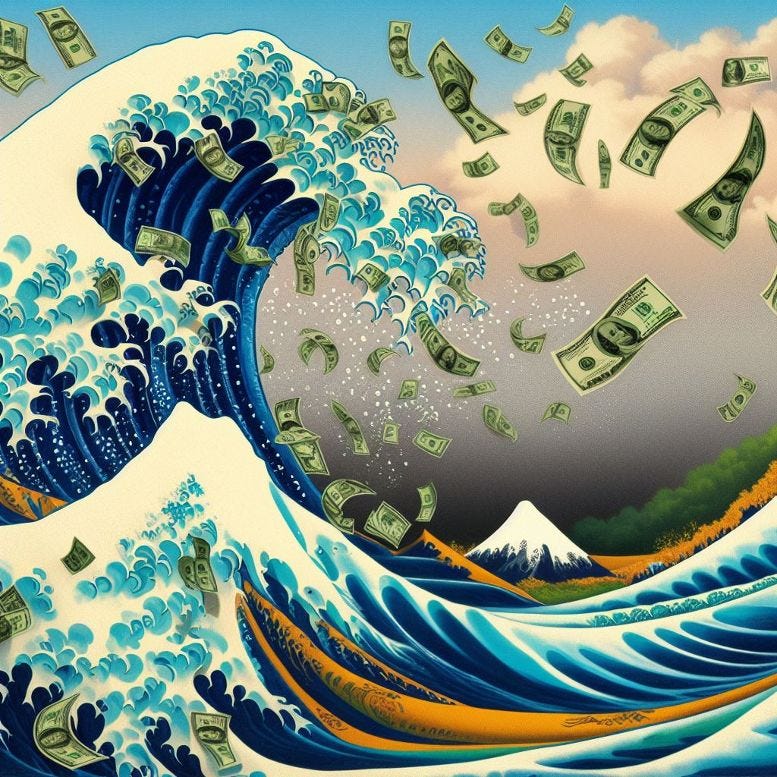Market Pulse: Snowflakes Melt in Spring
In 7 minutes, let's discuss Snowflake's disastrous earnings call and the possible last gasp of the ongoing bull market.
In 7 minutes, let's discuss Snowflake's disastrous earnings call and the possible last gasp of the ongoing bull market.
📉 SNOW earnings
Snowflake reported earnings on Wednesday and the market didn’t like the results at all. The stock crashed 25% in after-hours trading.
The two main reasons for the crash are a surprise retirement of embattled CEO Frank Slootman (Fortune: “Snowflake CEO calls his role 'insanely confrontational'”, June 2023) and a weaker-than-expected first quarter guidance.
Snowflake, as a stock, has long been favored among institutions.
Berkshire Hathaway famously owns a stake in the company worth $1.2 billion. What’s so surprising about this stake is that it runs against Warren Buffett’s usual playbook of avoiding tech companies. Buffett has long been criticized for missing out on major high-flying internet stocks like Google, Facebook, and Amazon but he’s evidently not planning on missing out on Snowflake.
Brad Gerstner, a well-known manager of a major hedge fund, Altimeter, is also notably very bullish on Snowflake.
His fund has $6 billion in assets under management and he has a whopping 41% of it invested in Snowflake!
Altimeter’s massive weighting for Snowflake is extraordinarily unusual for hedge funds given the dangerous lack of ergodicity.
We just saw this danger play out after yesterday’s earnings call: Snowflake’s surprising departure of its CEO and its weak guidance cost Gerstner 10% of his fund overnight!
We often give hedge fund managers a lot of deference, calling them “smart money” among other honorifics, but this earnings call is a prime example that just because you have billions of dollars under management, that doesn’t mean you can’t get things dead wrong.
🌊 Massive Vanna and Charm Flows Coming Up
A torrential amount of bearish options positions (sold calls and long puts) for the S&P 500 are rolling off the market’s books on 3/15 (March’s monthly options expiry date AKA the March OpEx).
This is not only a quarterly OpEx, which is generally significantly larger than other OpEx’s, it’s also the first major OpEx after this month’s heightened bearishness which further increases the amount of bearish hedging.

Since a market sell-off didn’t happen, all these hedges are deeply underwater and as I’ve described in previous newsletter issues, expiring bearish options positions in a stable market will result in elevated buying flows from market makers.
Why?
Note: we refer to these flows as vanna and charm flows.
When the market purchases bearish options positions, options market makers are often on the other side of the trade and thus take on bullish options positions.
Market makers want to be market-neutral and so they hedge against these bullish options positions by shorting the market.
As these bearish options positions expire worthless from a market sell-off that didn’t materialize, the market makers have to buy back these shorts.
Given this exceptionally large upcoming March OpEx, we expect a tsunami of vanna and charm flows that will inundate the market with significant buying from market makers.
These flows will really start crescendo-ing two weeks before the OpEx, aka starting next week, and we expect to see very green markets between now and 3/15.
📉 The Bull Market’s Last Gasp?
While we shared the market’s concerns about a sell-off between mid-February and mid-March, we were also wary that a sell-off wouldn’t materialize.
This would be incredibly bullish.
As such, we didn’t over-hedge. In fact, the only hedging we did was buying VIX calls, which paid off handsomely during February’s VixEx, and increasing our cash position.
These moves proved prescient. The market didn’t fall.
We discussed all these ideas with premium subscribers in previous newsletter issues.
Our two main reasons for staying cautiously bullish for this mid-Feb to mid-March period are:
No major catalysts that could send the markets lower, besides Nvidia’s earnings. The earnings call ended up going very well.
When everyone expects the market to sell off, the market tends to not fall for a while. It’s kind of like a big middle finger to all the bearish positions. We think this is because of the increased pre-emptive hedging that dampens volatility while sophisticated market participants will front-run this hedging, culminating in heightened buying flows to match the hedging. As the market fails to sell off, this creates a short squeeze event that further pushes the market up.
Only when the early bears are exhausted can the market fall. We saw this happen right before the massive pandemic bear market.
The world was well aware of the rapidly spreading virus that was causing major lockdowns in Southeast Asia and Europe in the two months before the selling began in earnest in mid-February.
We think a similar, albeit smaller-in-scale, situation is brewing this year. February’s stable market served to exhaust the bears and we think there’s a good chance the market will fall after the March OpEx when the large vanna and charm flows disappear.
Why?





